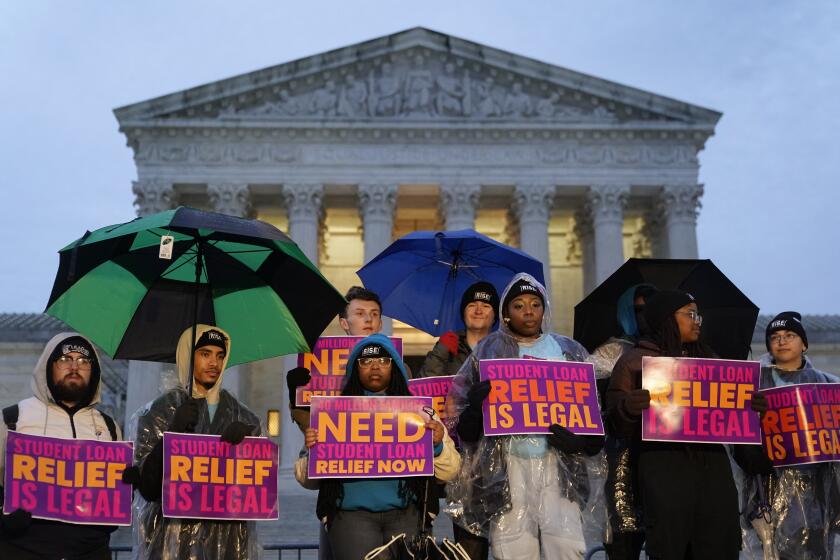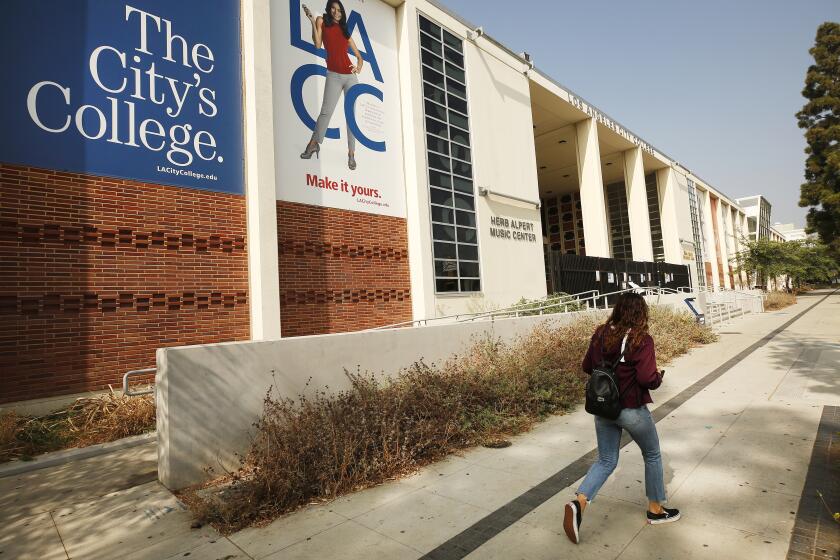How we can create a student loan system that doesn’t crush Americans — without cancelling the debts

- Share via
Some 44 million Americans owe $1.6 trillion in student loan debt, and more than 7 million of them were in default prior to the pandemic repayment pause. This crushing burden is associated with reduced homeownership, degraded credit ratings, and delayed marriage and childbearing. The Biden administration’s effort to cancel $430 billion of student loan debt, however, was struck down as unconstitutional by the Supreme Court.
Although advocates have pushed for blanket student loan forgiveness, a one-time loan cancellation was never going to be a lasting solution to the challenge of financing higher education in the U.S.
We still need to figure out how to help students invest in their education without saddling them with crushing debt in the first place. A critical step forward would be to replace the existing loan system with a standard repayment plan that aligns payments with a borrower’s ability to pay.
The Supreme Court didn’t rule that student debt can’t be forgiven; it merely said that government has to do it right or don’t do it at all.
Funding for postsecondary education in the U.S. comes from the public sector as well as from private gifts, contracts, student tuition and fees. But state and local contributions have not kept pace with the increase in cost. In 1980, tuition and fees paid by students represented only 13% of the cost of education at public institutions; by 2020, this share had risen to nearly 20%. Students and their families have increasingly borrowed to cover the cost.
There are many proposals for making higher education more affordable, such as offering free (two-year) community college or eliminating student loans altogether. Given that postsecondary schooling yields benefits for all of society — through greater tax contributions, higher productivity, reduced dependence on the social welfare system, and so forth — some public subsidization of the cost of higher education makes sense.
At the same time, it also makes sense for students to bear some responsibility for a share of the cost of the education, which produces benefits, such as a boost lifetime earnings. Given the substantial return on investment, it is appropriate that loans remain in financial aid packages.
The conservative court ruled against Biden’s debt relief program that would have helped more than 40 million people.
But the standard federal student loan does not align with the economic realities of postsecondary schooling and the labor market. And, though education is an investment that does not pay off for everyone, students face complex and limited options for reducing repayment burdens and are prohibited from discharging the debt through bankruptcy.
Equally important, the standard repayment plan expects students to repay their loans over the first 10 years of their careers, before most have hit their peak earnings. Even for those whose investment pays off over time, the financial burden may be too high during the repayment period.
Aiming to solve these problems, Congress and the Department of Education have, over time, created several income-driven repayment programs — a bipartisan idea that arose decades ago, when it was endorsed by economists across the political spectrum. Unlike a mortgage, which requires borrowers to pay a predetermined amount each month, income-driven repayment plans set the payment at a percentage of borrowers’ income. Under a well-designed plan, borrowers who fall on hard times or select an occupation that does not pay well (such as working in the public sector) would be able to repay what they can of their loans without undue financial hardship.
But the existing plans are not optimally designed. Borrowers must opt into such a plan over the standard repayment plan. Payments are based on the prior year’s income, which means they do not seamlessly adjust to changes in borrowers’ earnings and employment circumstances. Nor do they automatically adjust to borrowers’ current hardships, necessitating complicated forbearance and deferment rules and requiring annual recertification. Further, the plans have different eligibility rules, payment rates, repayment periods and definitions of discretionary income. As a result, choosing a plan is so confusing that to date only a minority of eligible borrowers take advantage of them.
Using a college degree to earn a higher salary and climb ladders of economic mobility is not as easy as it once was.
As a stopgap measure, the Biden administration has introduced Saving on a Valuable Education, a larger, more generous income-driven repayment plan than the existing options. The hope is that the new program will be so obviously advantageous that more students will sign up for it. But SAVE is far from perfect. It will not be the default plan, and it still bases payments on the past year’s income. As a result, it is not clear how effective it will be at addressing the country’s student debt crisis and higher-education financing challenges.
More to the point, SAVE is an expensive plan layered on top of a labyrinth of other student loan options. That brings us to the larger problem: The Department of Education cannot simply eliminate plans created by Congress. Genuinely transforming federal student loans requires Congress to phase out all existing income-driven payment plans and replace them with a well-structured plan as the default. Ideally, such a plan would be administratively straightforward and designed to encourage students to assume a responsible level of debt to pay for valuable education programs.
While even a well-designed plan would not solve all the problems in the financing of higher education in the U.S., making income-driven repayment the default plan for student loans would be a huge improvement, and is a reform that both parties should be able to get behind.
Cecilia Elena Rouse, former chair of President Biden’s Council of Economic Advisors, is a professor of economics and public affairs at Princeton University.
More to Read
A cure for the common opinion
Get thought-provoking perspectives with our weekly newsletter.
You may occasionally receive promotional content from the Los Angeles Times.












